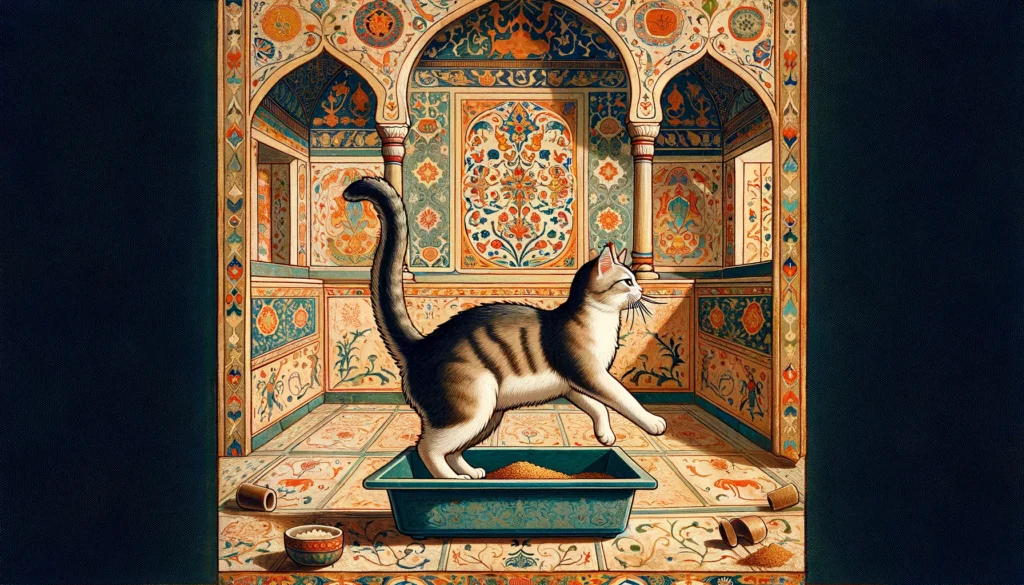Have you ever caught your cat frolicking in their litter box and wondered why? This piece dives into the captivating reasons behind such behavior, exploring “why do cats play in their litter box.”
It might seem odd at first, but there are genuine reasons for your cat exhibiting this behavior ranging from curiosity to seeking comfort. In fact, this cat litter mystery is more common than you might think and understanding it can enhance your bond with your furry friend.
Let’s unravel this puzzle together, shall we?
To get started on understanding why do cats play in their litter box, consider these three tips:
- Observe your cat’s overall behavior and environment to see if changes might be affecting them.
- Enhance your cat’s play area with more toys and engagement opportunities outside the litter box.
- Consult with a veterinarian if you notice any health issues or changes in litter box habits, as it might be more than just play.
Transitioning into our discussion, we’ll explore each reason in detail, providing you with the knowledge to understand your cat’s litter tray activities.
Key Takeaways
- Observe Behavior: Pay close attention to your cat’s litter box habits to catch early signs of health issues or stress.
- Provide Alternatives: Redirect your cat’s attention with interactive toys and enrichment activities to discourage inappropriate litter box play.
- Select Appropriate Supplies: Choose the right type and size of litter and litter boxes based on your cat’s preferences to encourage proper use.
- Consult Professionals: Seek advice from veterinarians for any health concerns indicated by changes in litter box behavior.
- Create a Stimulating Environment: Enhance your cat’s living space with climbing structures and scratching posts to satisfy their natural instincts and curiosity.
You may also like – 5 Reasons Why Cats Dig in the Litter Box

Exploring Cats’ Natural Curiosity
Delving into cats’ fascination with their litter boxes reveals much about their instinctual actions and curiosity.
1. The Lure of Litter Tray Activities
Cats, especially kittens, are drawn to the litter pan as a source of entertainment and exploration.
- Cats see litter pans as mini playgrounds.
- Litter texture stimulates their curiosity.
- Kittens learn and mimic through play.
2. Digging and Scratching: Innate Cat Behavior
Digging and scratching in the litter box are not just playful actions; they’re part of their instinctual bathroom habits.
- Digging helps them hide from predators.
- Scratching keeps their nails sharp.
- These actions mark their territory.
Behavioral Insights into Litter Box Play
Examining cats’ playtime in litter boxes from a behavioral perspective reveals much about their comfort zone and stress relief needs.
3. Stress Relief and Comfort Zone
For some cats, playing in the litter box serves as stress relief, offering a familiar comfort zone.
- Stress relief through digging and burying mimics natural behaviors.
- A comfort zone within the litter box can make cats feel secure.
- Litter box play can distract from environmental stressors.
4. Territorial Instincts in the Litter Box
Marking territory through playful antics in the litter box underscores their territorial instincts.
- Territorial marking is achieved through scratching and burying.
- The litter box offers a controlled space for scent marking.
- Cats may feel an enhanced sense of ownership over their environment.
Health Considerations in Litter Box Usage
While cats’ play in their litter box can often be innocent, it’s essential to consider potential health implications.
5. Recognizing Health Signals Through Litter Box Behavior
Excessive time spent in litter boxes can sometimes signal health issues, necessitating a closer look.
- Frequent urination could indicate a urinary tract issue.
- Lethargy or loss of appetite may accompany this behavior.
- Immediate vet consultation is recommended for drastic changes.
6. The Importance of Monitoring Litter Box Activities
Keeping an eye on litter box behavior is crucial for early detection of possible health concerns.
- Note changes in frequency, consistency, and effort.
- Behavioral shifts alongside litter box use can hint at discomfort.
- Regular check-ups can preempt serious conditions.
Understanding and addressing these health considerations promptly can ensure our feline friends lead a happy, healthy life. Observing and reacting to changes in litter box behavior can be key to preventing more serious health issues down the line.

Creating an Engaging Environment Beyond the Litter Box
Understanding the underlying reasons for litter box play can lead to improvements in your cat’s environment.
7. Alternative Play and Enrichment
Offering alternative forms of play can redirect your cat’s attention from the litter box to more appropriate entertainment outlets.
- Interactive toys keep them mentally stimulated.
- Climbing structures and scratching posts mimic natural activities.
- Scheduled playtimes reinforce positive behaviors.
Creating a stimulating home environment enriches your cat’s daily life, fostering both physical health and emotional well-being. This proactive approach helps satisfy their innate instincts and curiosities in a constructive manner.
8. Choosing the Right Litter and Boxes
Selecting litter and boxes that suit your cat’s preferences can minimize unwanted litter box play.
- Experiment with different types of litter to see which one your cat prefers.
- Consider the size and privacy of the litter box, as some cats have strong preferences.
- Multiple boxes in different locations can prevent territorial issues.
By attentively choosing the right litter and box, you encourage proper litter box usage, reducing the likelihood of play where it’s not meant to happen. This attention to detail supports your cat’s comfort and hygiene.
Frequently Asked Questions
Q: What Motivates Cats to Play in Their Litter Boxes?
A: Cats often play in their litter boxes due to their natural instincts and curiosity. These behaviors can also be attributed to the texture and digging opportunities that the litter provides, offering a stimulating environment for play.
Q: Is It Normal for Cats to Find Amusement in Their Litter Boxes?
A: Yes, it is relatively normal for cats to find amusement in their litter boxes. This behavior is typically a sign of their exploratory nature, though it’s important to monitor for any changes that might indicate health or behavioral issues.
Q: How Can I Discourage My Cat from Playing in the Litter Box?
A: To discourage your cat from playing in the litter box, provide alternative play areas and engaging toys. Ensuring that they have plenty of other stimulating activities and a clean, appealing litter box can help redirect their playful tendencies elsewhere.
Q: Should I Be Concerned If My Cat Frequently Plays in the Litter Box?
A: If your cat frequently plays in the litter box, it’s advisable to observe their overall behavior and health. While it can be a normal behavior, excessive time spent in the litter box may indicate boredom, stress, or a medical issue that should be checked by a vet.
These rewritten questions and answers can serve as a helpful guide for understanding and managing your cat’s litter box play behavior.
Further Reading
Why Does My Cat Play in the Litterbox?
Conclusion
Recognizing the reasons behind litter box play is a step towards fostering a healthy and engaging environment for cats. This understanding allows us to better cater to their needs, ensuring a happy, well-adjusted pet.
- Observe your cat’s behavior closely for any changes or preferences.
- Consult with veterinarians when necessary to address potential health issues.
- Enhance your cat’s environment with toys, climbing structures, and multiple litter boxes to encourage healthy play.
By integrating these insights and recommendations, you can create a living space that meets your cat’s physical and psychological needs, ensuring they lead a fulfilling life as part of your family.


